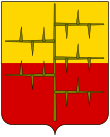Ricciarda Cybo-Malaspina

Ricciarda Malaspina (1497 – 15 June 1553) was an Italian noblewoman, who was marquise of Massa and lady of Carrara from 1519 to 1546, and again from May 1547 until her death in 1553.[1] She was ultimately succeeded by her younger son Alberico I.
Life[edit]
Born in Massa, she was the daughter of Antonio Alberico II Malaspina and Lucrezia d'Este. His father in 1481 had become marquis of Massa and lord of Carrara, in condominium with his brother Francesco, whom however he soon ousted from power. Having no sons, Antonio Alberico, in violation of Salic law, named his first daughter, Eleonora, as heiress to his titles. Elenora was married to Scipione Fieschi, count of Lavagna, but she died in 1515. The following year Fieschi would marry again, to his sister-in-law, Ricciarda. The marriage lasted for four years, until he too died without male issue.
After Antonio Alberico's death in 1519, notwithstanding her being a woman and in spite of the Salic law, Ricciarda succeeded in maintaining control over his states. The following year she married Lorenzo Cybo, a Genoese nobleman who was a grandson of Pope Innocent VIII and Lorenzo de' Medici, and a nephew of Pope Leo X, thus founding the Cybo-Malaspina family, who would hold Massa and Carrara until 1829.
In a period in which Italy was overrun by the war between France, the Holy Roman Empire, and the Italian states, she was able to wangle her way through the various major powers and, despite being a relative of Pope Clement VII by marriage and having lived in Rome for a long time, she managed to win the Emperor Charles V's favour. Thus, in 1529, also to counter her husband's ambitions to get his hands on her father's fiefdoms, she succeeded in getting invested with them suo jure with a truly unusual imperial decree: in derogation of the Salic law, it gave her the right to transmit her titles not only to her male descendants, but, in their absence, also to females, always respecting the newly established principle of primogeniture. The following year her husband went on the counterattack and in turn managed to get himself appointed "co-owner" of the two fiefdoms.
Nevertheless, after Lorenzo's failed attempt to oust her from the throne with violence, in 1541 Ricciarda managed to have the 1530 imperial decree revoked and thus get rid of his claims for good. When their son Giulio came of age, it was he that extorted the lordship from her (1546), but she took back the reins after his involvement in a pro-France plot in 1547, which led to his decapitation in Milan the following year. She continued to reign over Massa until her death in 1553. She was succeeded by her other son Alberico, officially held to be legitimate but most probably the son of Cardinal Innocenzo Cybo, Ricciarda's brother-in-law and her long-time lover en titre and mentor. In her will she imposed on her successors the obligatory clause that they should bear her family surname Malaspina alongside their paternal one Cybo.
She was a strong and stubborn woman ahead of her time, pleasure-loving and of easy virtue but also proud of her own prerogatives and determined to defend them at all costs even against her male family members who opposed her. It was thanks to the results achieved during her tragic life that the states of Massa and Carrara eventually had the chance of being governed, in their last hundred years of autonomous existence, by three illustrious duchesses : Ricciarda Gonzaga, as regent (1731 to 1744), and, as legitimate rulers, her daughter Maria Teresa Cybo-Malaspina (1731 to 1790) and the latter's daughter Maria Beatrice d'Este (1790 to 1829), who were entitled to reign despite their being women only because they descended from marquise Ricciarda Malaspina.
Children[edit]
From her first marriage Ricciarda had only one daughter, Isabella Fieschi.
From her second marriage Ricciarda had three children who survived to adulthood:
- Eleonora Cybo (1523–1594);
- Giulio I Cybo-Malaspina, Marquis of Massa (1525-1547) dethroned his mother in 1546–1547;
- Alberico I Cybo-Malaspina, Prince of Massa (1534-1623) succeeded his mother following her death.
Ricciarda also had several illegitimate children:
- Alessandro, Clemente, Elena e Ricciarda, later legitimized by her brother-in-law Cardinal Innocenzo Cybo, their father;
- Scipione, by her lover, the imperial ambassador to Rome, Giovan Ferdinando Manrique d'Aguilar;
- Giulia Cybo, of uncertain paternity (possibly another member of the Cybo family).
References[edit]
- ^ Leone Tettoni-Francesco Saladini, La famiglia Cybo e Cybo Malaspina, Palazzo di S. Elisabetta, Massa 1997.
Bibliography[edit]
- Calonaci, Stefano (2006). "Malaspina, Ricciarda". In Dizionario Biografico degli Italiani, volume 67, Enciclopedia Italiana


